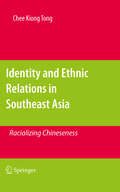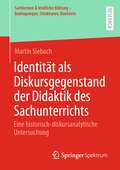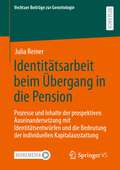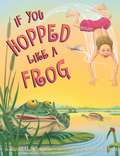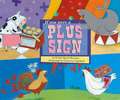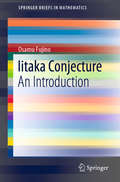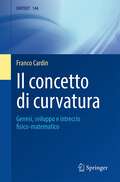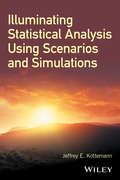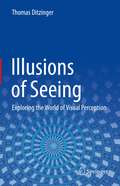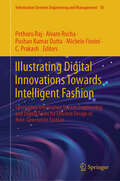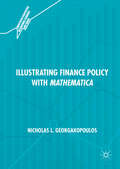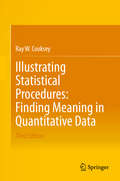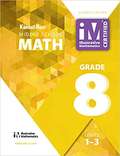- Table View
- List View
Identity and Ethnic Relations in Southeast Asia
by Chee Kiong TongModern nation states do not constitute closed entities. This is true especially in Southeast Asia, where Chinese migrants have continued to make their new homes over a long period of time, resulting in many different ethnic groups co-existing in new nation states. Focusing on the consequences of migration, and cultural contact between the various ethnic groups, this book describes and analyses the nature of ethnic identity and state of ethnic relations, both historically and in the present day, in multi-ethnic, pluralistic nation states in Southeast Asia. Drawing on extensive primary fieldwork in Malaysia, Singapore, Indonesia, Burma, Vietnam, Thailand and the Philippines, the book examines the mediations, and transformation of ethnic identity and the social incorporation, tensions and conflicts and the construction of new social worlds resulting from cultural contact among different ethnic groups.
Identität als Diskursgegenstand der Didaktik des Sachunterrichts: Eine historisch-diskursanalytische Untersuchung (Sachlernen & kindliche Bildung – Bedingungen, Strukturen, Kontexte)
by Martin SiebachDer Auseinandersetzung mit Identität kommt im Kontext gesellschaftlicher Transformationsprozesse der letzten Jahrzehnte eine immer größere Bedeutung zu. Identität ist zu einem zentralen Thema in Gesellschaft und Wissenschaft geworden. Eine Beteiligung der Sachunterrichtsdidaktik an diesem Diskurs wäre aufgrund der Bildungsauftrags des Unterrichtsfachs, zentrale gesellschaftliche Probleme zu thematisieren und eine breite und vielfältige Interessenförderung aller Schüler*innen zu gewährleisten zu erwarten. Außerdem haben viele curriculare Themen des Schulfachs Sachunterricht identitätsbezogene Aspekte, so körperliche Entwicklung, Geschlecht, Gender, Sexualität, Trans- bzw. Interkulturalität, Arbeit und Berufe. In der Sachunterrichtsdidaktik wäre dementsprechend eine identitätsbezogene Kontextualisierung solcher fachlichen Aspekte nötig und erwartbar. In dieser Arbeit wird für die Sachunterrichtsdidaktik geklärt, inwiefern die Thematisierung von „Identität“ in der Sachunterrichtsdidaktik diesen Erwartungen entspricht und somit als dem aktuellen Stand des sozialwissenschaftlichen Diskurses entsprechend gelten kann.
Identitätsarbeit beim Übergang in die Pension: Prozesse und Inhalte der prospektiven Auseinandersetzung mit Identitätsentwürfen und die Bedeutung der individuellen Kapitalausstattung (Vechtaer Beiträge zur Gerontologie)
by Julia ReinerAngesichts des Spannungsfelds aus Gewinnen und Verlusten, neuen Gestaltungsfreiheiten und -notwendigkeiten kann der Übergang in die Pension als besonders sensible Phase für Identitätsarbeit erachtet werden. Dies gilt speziell für die zukunftsorientierte Auseinandersetzung mit Identitätsentwürfen im Sinne von prospektiver Identitätsarbeit. Im Rahmen einer mehrphasigen Mixed-Methods-Studie untersucht Julia Reiner Prozesse und Inhalte von prospektiver Identitätsarbeit beim Übergang in die Pension und stellt in diesem Zusammenhang auch die Frage nach der Bedeutung der individuellen Kapitalausstattung. Durch die Verschränkung unterschiedlicher theoretischer Perspektiven und deren empirische Bearbeitung leistet die Untersuchung einen wertvollen Beitrag für die Identitäts- und Pensionierungsforschung sowie für Fragen sozialer Ungleichheit in diesen beiden Forschungsfeldern.
Ideology and Spatial Voting in American Elections
by Stephen A. JesseeIdeology and Spatial Voting in American Elections addresses two core issues related to the foundations of democratic governance: how the political views of Americans are structured and how citizens' voting decisions relate to their ideological proximity to the candidates. Focusing on testing the assumptions and implications of spatial voting, this book connects the theory with empirical analysis of voter preferences and behavior, showing Americans cast their ballots largely in accordance with spatial voting theory. Stephen A. Jessee's research shows voters possess meaningful ideologies that structure their policy beliefs, moderated by partisanship and differing levels of political information. Jessee finds that while voters with lower levels of political information are more influenced by partisanship, independents and better informed partisans are able to form reasonably accurate perceptions of candidates' ideologies. His findings should reaffirm citizens' faith in the broad functioning of democratic elections.
If Venice Dies
by Salvatore Settis&“This powerful book of cultural criticism&” by the renowned art historian &“shines a harsh light on&” a historic city&’s destruction in the name of profit (The Washington Post). What is Venice worth? To whom do its irreplaceable treasures belong? This eloquent book by art historian Salvatore Settis urgently poses these questions, igniting a new debate about urban stewardship and cultural patrimony at large. As Venice grows increasingly unaffordable and inhospitable to its own residents, Venetians are abandoning their hometown at an alarming rate. At last count, there was only one local for every 140 visitors. As it capitulates to tourists and those who profit from them, Venice&’s transformation into a lifeless shell of itself has become emblematic of the future of historic cities everywhere. In this blend of history and cultural analysis, written with wide-ranging erudition and élan, Settis makes a passionate plea to secure the soul of Venice. &“Anyone interested in learning what is really going on in Venice should read this book.&” —Donna Leon, author of My Venice and Other Essays and Death at La Fenice
If You Hopped Like A Frog (If You... Ser.)
by David M. SchwartzHow far could you hop?If you hopped like a frog...you could jump from home plate to first base in one mighty leap!Did you know that a frog can jump 20 times its body length? Or that an ant can lift an object 50 times its own weight?Read this book and find out what you could do -- if you had the amazing abilities of animals! And there are endless possibilities for making more hilarious comparisons of your own. Get ready for ratio and proportion like you've never seen them before!
If You Hopped like a Frog
by David M. SchwartzDid you know that a frog can jump 29 times its body length? Or that an ant can lift an object 50 times its weight?
If You Were A Plus Sign (Math Fun)
by Francesca Carabelli Trisha Speed ShaskanWhat could you do if you were a plus sign? You could add things together. You could add people and animals. You could add up and down or side to side. Discover even more answers in this installment of the bestselling MATH FUN series by Trisha Speed Shaskan! With creative examples, easy-to-understand text, and engaging art, these entertaining and educational picture books books are perfect for young math lovers to read aloud or read alone.
If You Were a Minus Sign (Math Fun)
by Francesca Carabelli Trisha Speed ShaskanWhat could you do if you were a minus sign? You could subtract one number from another. You could subtract food and balloons. In every problem, you would find the difference. Discover even more answers in this installment of the bestselling MATH FUN series by Trisha Speed Shaskan! With creative examples, easy-to-understand text, and engaging art, these entertaining and educational picture books books are perfect for young math lovers to read aloud or read alone.
Ignorance and Uncertainty (Econometric Society Monographs #61)
by Olivier Compte Andrew PostlewaiteBorn of a belief that economic insights should not require much mathematical sophistication, this book proposes novel and parsimonious methods to incorporate ignorance and uncertainty into economic modeling, without complex mathematics. Economics has made great strides over the past several decades in modeling agents' decisions when they are incompletely informed, but many economists believe that there are aspects of these models that are less than satisfactory. Among the concerns are that ignorance is not captured well in most models, that agents' presumed cognitive ability is implausible, and that derived optimal behavior is sometimes driven by the fine details of the model rather than the underlying economics. Compte and Postlewaite lay out a tractable way to address these concerns, and to incorporate plausible limitations on agents' sophistication. A central aspect of the proposed methodology is to restrict the strategies assumed available to agents.
Iitaka Conjecture: An Introduction (SpringerBriefs in Mathematics)
by Osamu FujinoThe ambitious program for the birational classification of higher-dimensional complex algebraic varieties initiated by Shigeru Iitaka around 1970 is usually called the Iitaka program. Now it is known that the heart of the Iitaka program is the Iitaka conjecture, which claims the subadditivity of the Kodaira dimension for fiber spaces. The main purpose of this book is to make the Iitaka conjecture more accessible. First, Viehweg's theory of weakly positive sheaves and big sheaves is described, and it is shown that the Iitaka conjecture follows from the Viehweg conjecture. Then, the Iitaka conjecture is proved in some special and interesting cases. A relatively simple new proof of Viehweg's conjecture is given for fiber spaces whose geometric generic fiber is of general type based on the weak semistable reduction theorem due to Abramovick–Karu and the existence theorem of relative canonical models by Birkar–Cascini–Hacon–McKernan. No deep results of the theory of variations of Hodge structure are needed. The Iitaka conjecture for fiber spaces whose base space is of general type is also proved as an easy application of Viehweg's weak positivity theorem, and the Viehweg conjecture for fiber spaces whose general fibers are elliptic curves is explained. Finally, the subadditivity of the logarithmic Kodaira dimension for morphisms of relative dimension one is proved. In this book, for the reader's convenience, known arguments as well as some results are simplified and generalized with the aid of relatively new techniques.
Il concetto di curvatura: Genesi, sviluppo e intreccio fisico-matematico (UNITEXT #146)
by Franco CardinQuesto breve libro propone con uno spirito via via d’immagine storiografica e di dettaglio matematico, la nascita e l’evoluzione del concetto di curvatura: le sue origini ancestrali nella meccanica, nell’astronomia, nella geodesia, e infine, chiaramente nella geometria. Gli aspetti tecnici, a volte estremamente semplici, altre volte complessi, sono sempre accompagnati da spiegazioni che si sperano esaurienti.È ben noto che su entrambi i versanti culturali proposti nel libro, molto si è scritto e ad altissimo livello; qui, c’è un tentativo di sintesi, della storiografia e della matematica sul tema della curvatura. Il racconto del filo che intercorre tra Huygens, Gauss, Riemann, Christoffel, Ricci Curbastro, Levi-Civita e infine Einstein, è stato sicuramente già ben proposto sul versante puramente storico o in quello prettamente matematico: è una speranza che la narrazione qui presentata, con questi punti di vista intrecciati, sia infine soddisfacente. Il tentativo andava fatto. L’augurio forte è che gli argomenti narrati risultino coinvolgenti per il lettore, spingendolo ad esplorare autonomamente altri aspetti magari nascosti nelle pieghe della nozione di curvatura e del mondo che ci vive attorno. Il volume muove inizialmente dal racconto di qualche frammento di cosmologia antica e medioevale. Tutto ciò è solo apparentemente estraneo al corpo vivo della materia: ritroveremo per esempio che la concezione cosmologica di Dante, riassunta qui matematicamente, propose un universo come un’ipersfera 3-dimensionale che, quasi incidentalmente, risulterà proprio il modello cosmologico offerto da Einstein nel 1917 per il suo universo chiuso e statico. Ed è proprio la curvatura che domina quella scena, oggetto matematico protagonista della teoria della relatività generale einsteniana. I personaggi prima elencati vengono comunque narrati anche nelle loro salienti vicende umane, a volte altamente drammatiche, come accadde per esempio per Riemann e Tullio Levi-Civita. In un certo senso, la storia della curvatura accompagna la storia dell’umanità.Benché inizialmente sia stato generato da un disegno didattico, il volume è indirizzato ad un pubblico non necessariamente studentesco, con una cultura scientifica di base.
Illinois Math Connects: Concepts, Skills, And Problems Solving, Course 2
by Mcgraw-Hill StaffMath Connects: Concepts, Skills, and Problem Solving was written by the authorship team with the end results in mind. They looked at the content needed to be successful in Geometry and Algebra and backmapped the development of mathematical content, concepts, and procedures to PreK to ensure a solid foundation and seamless transition from grade level to grade level. The series is organized around the new NCTM Focal Points and is designed to meet most state standards. Math Connects focuses on three key areas of vocabulary to build mathematical literacy, intervention options aligned to RtI, and a comprehensive assessment system of diagnostic, formative, and summative assessments.
Illuminating Statistical Analysis Using Scenarios and Simulations
by Jeffrey E. KottemannFeatures an integrated approach of statistical scenarios and simulations to aid readers in developing key intuitions needed to understand the wide ranging concepts and methods of statistics and inference Illuminating Statistical Analysis Using Scenarios and Simulations presents the basic concepts of statistics and statistical inference using the dual mechanisms of scenarios and simulations. This approach helps readers develop key intuitions and deep understandings of statistical analysis. Scenario-specific sampling simulations depict the results that would be obtained by a very large number of individuals investigating the same scenario, each with their own evidence, while graphical depictions of the simulation results present clear and direct pathways to intuitive methods for statistical inference. These intuitive methods can then be easily linked to traditional formulaic methods, and the author does not simply explain the linkages, but rather provides demonstrations throughout for a broad range of statistical phenomena. In addition, induction and deduction are repeatedly interwoven, which fosters a natural "need to know basis" for ordering the topic coverage. Examining computer simulation results is central to the discussion and provides an illustrative way to (re)discover the properties of sample statistics, the role of chance, and to (re)invent corresponding principles of statistical inference. In addition, the simulation results foreshadow the various mathematical formulas that underlie statistical analysis. In addition, this book: • Features both an intuitive and analytical perspective and includes a broad introduction to the use of Monte Carlo simulation and formulaic methods for statistical analysis • Presents straight-forward coverage of the essentials of basic statistics and ensures proper understanding of key concepts such as sampling distributions, the effects of sample size and variance on uncertainty, analysis of proportion, mean and rank differences, covariance, correlation, and regression • Introduces advanced topics such as Bayesian statistics, data mining, model cross-validation, robust regression, and resampling • Contains numerous example problems in each chapter with detailed solutions as well as an appendix that serves as a manual for constructing simulations quickly and easily using Microsoft® Office Excel® Illuminating Statistical Analysis Using Scenarios and Simulations is an ideal textbook for courses, seminars, and workshops in statistics and statistical inference and is appropriate for self-study as well. The book also serves as a thought-provoking treatise for researchers, scientists, managers, technicians, and others with a keen interest in statistical analysis. Jeffrey E. Kottemann, Ph.D., is Professor in the Perdue School at Salisbury University. Dr. Kottemann has published articles in a wide variety of academic research journals in the fields of business administration, computer science, decision sciences, economics, engineering, information systems, psychology, and public administration. He received his Ph.D. in Systems and Quantitative Methods from the University of Arizona.
Illusions of Seeing: Exploring the World of Visual Perception
by Thomas DitzingerWhy do we need two eyes? Why are all cats grey at night and appear to move faster the day? Why is the sky blue and the setting sun red? This book explains the multifaceted nature of perception, and discusses the mysteries of vision. It provides readers with experiments to help them discover optical illusions and the features of their own perception. Illusions of Seeing begins with a discussion on the essence of light and its perception to the human eye. It presents a comprehensive overview of the basic laws of human perception as well as the fundamentals of good gestalt. Subsequent chapters discuss geometric-optical illusions; the perception of form, brightness, and translucency and their interaction with each other; ambiguous perception, color vision, spatial vision. The book ends with a discussion of the perception of motion and its interaction with color, form, and spatial depth with a full chapter devoted to illusions in our everyday life. Consider this your travel guide in the marvelous world of sight, to experience a completely individual way to understand and improve your own perception.Illusions of Seeing will be of interest to psychologists, physicists, biologists, and undergraduate and graduate students within the field of cognitive psychology.
Illustrating Digital Innovations Towards Intelligent Fashion: Leveraging Information System Engineering and Digital Twins for Efficient Design of Next-Generation Fashion (Information Systems Engineering and Management #18)
by Pethuru Raj Alvaro Rocha Pushan Kumar Dutta C. Prakash Michele FioriniThis book presents the mass manufacturing and manifestation of smart clothes that have decisively kick-started the fashion industry With the flourishing of edge and digitization technologies, every tangible thing in and around us is all set to become digitized. The arrival of advanced communication and digitalization technologies has made any digitized entity to be connected and cognitive. With this transition, the textile industry is strategizing to leverage the improvisations being accomplished in the digital era to design, develop, and deliver digitally enabled dresses and clothes. Smart attires are fabrics bedded with ultrathin, flexible and transparent detectors, selectors, electronics, and connectivity, and there are nano-creators to power smart dresses. The mass manufacturing and manifestation of smart clothes have decisively kick-started the fashion industry. The readers will come across the implementation technologies and the research results of virtual try-on, body size and pose estimation, diffusion-based fashion synthesis, etc.
Illustrating Finance Policy with Mathematica (Quantitative Perspectives On Behavioral Economics And Finance Ser.)
by Nicholas L. GeorgakopoulosStudents in various disciplines—from law and government to business and health policy—need to understand several quantitative aspects of finance (such as the capital asset pricing model or financial options) and policy analysis (e.g., assessing the weight of probabilistic evidence) but often have little quantitative background. This book illustrates those phenomena and explains how to illustrate them using the powerful visuals that computing can produce. Of particular interest to graduate students and scholars in need of sharper quantitative methods, this book introduces the reader to Mathematica, enables readers to use Mathematica to produce their own illustrations, and places specific emphasis on finance and policy as well as the foundations of probability theory.
Illustrating Statistical Procedures: Finding Meaning in Quantitative Data
by Ray W. CookseyThis book occupies a unique position in the field of statistical analysis in the behavioural and social sciences in that it targets learners who would benefit from learning more conceptually and less computationally about statistical procedures and the software packages that can be used to implement them. This book provides a comprehensive overview of this important research skill domain with an emphasis on visual support for learning and better understanding. The primary focus is on fundamental concepts, procedures and interpretations of statistical analyses within a single broad illustrative research context. The book covers a wide range of descriptive, correlational and inferential statistical procedures as well as more advanced procedures not typically covered in introductory and intermediate statistical texts. It is an ideal reference for postgraduate students as well as for researchers seeking to broaden their conceptual exposure to what is possible in statistical analysis.
Illustrative Mathematics Student Workbook: Book 1: Units 1, 2, 3,
by Illustrative MathematicsNIMAC-sourced textbook <p>Grade 7
Illustrative Mathematics Student Workbook: Book 2: Units 4, 5, 6
by Illustrative MathematicsNIMAC-sourced textbook <p>Grade 7
Illustrative Mathematics, Grade 8, Book 1: Units 1, 2, 3
by Illustrative MathematicsNIMAC-sourced textbook
Illustrative Mathematics, Grade 8, Book 2: Units 4, 5, 6
by Illustrative MathematicsNIMAC-sourced textbook
Illustrative Mathematics, Grade 8, Book 3: Units 7, 8, 9
by Illustrative MathematicsNIMAC-sourced textbook
Illustrative Mathematics: Grade 6 Units 1-3
by Kendall HuntThis book includes public domain images or openly licensed images that are copyrighted by their respective owners. Openly licensed images remain under the terms of their respective licenses. See the image attribution section for more information.
